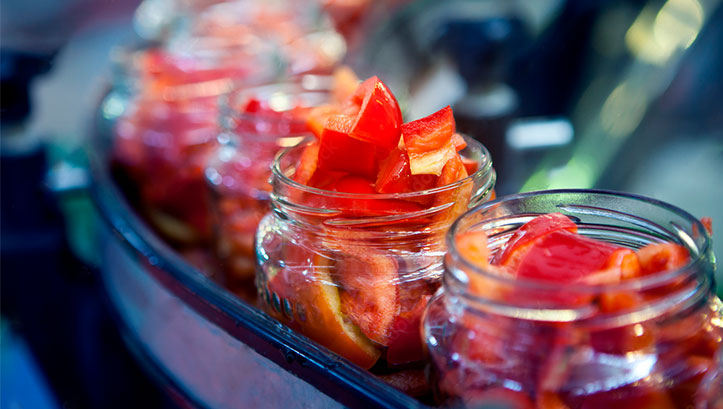Vegetable processing today has seen significant advancements in terms of technology, methods and approaches. This processing can involve both the preparation of vegetables for immediate consumption and their long-term conservation.
Being at the forefront of these advances allows us to follow the most innovative trends and methods in the sector for processing vegetables, such as:
- Advanced Technology: Automation and advanced technology play a crucial role in vegetable processing. This includes specialized machinery to efficiently peel, cut, wash and package vegetables.
- Preservation methods: Vegetables are processed in various ways to prolong their shelf life. These methods include vacuum packaging, freezing, dehydrating, and fermentation. Each of these methods has a series of advantages and disadvantages in terms of flavor, texture and nutritional value.
- Freshness preservation technologies: Technologies have been developed to maintain the freshness of vegetables for longer. This includes controlled atmospheres, where oxygen and carbon dioxide levels in storage are adjusted to slow food degradation.
- Convenience products: Consumers are increasingly looking for convenience foods. This has led to the development of products such as pre-cut salads, ready-to-use frozen vegetables and packaged soups, making it easy to prepare quick and healthy meals.
- Functional foods: The trend towards healthier eating has driven the creation of functional foods enriched with vitamins, minerals and other beneficial components, often from processed vegetables.
- Minimum waste: There is a growing focus on reducing food waste. Edible parts of vegetables that used to be thrown away, such as stems and leaves, are now used in the production of food products or promoted as healthy ingredients.
- Organic and sustainable foods: Consumers are showing increasing interest in organic and sustainable products. This has led to an increase in the processing of organically grown vegetables and more environmentally friendly methods.
- Quality improvement technology: Technologies have been developed to detect and remove defects in vegetables, such as spots or unwanted chemicals, before they reach the market.
- Personalization and dietary trends: Consumers are looking for vegetable processing options that fit their dietary needs and preferences, such as gluten-free, vegan or low-carb products.
Overall, vegetable processing has evolved to adapt to changing consumer demands in terms of quality, taste, convenience and sustainability. Current trends are influenced by technology, nutrition and environmental awareness.
The facilities that we design for the processing of vegetables in the food industry are fully prepared and automated to carry out all the stages that transform raw vegetables into processed products ready for sale and consumption: reception, selection, washing, disinfection, peeling , cutting, blanching, rinsing, cooling, packaging and storage.
Technology plays a fundamental role in each of these stages, so our equipment is specially designed to increase efficiency, reduce manual work and ensure food quality and safety at all times. Among the most common machines we design for vegetable processing are:
- Washers and disinfectors: These machines are used to clean and disinfect vegetables, removing dirt, pesticides and other contaminants. They can use water, air or disinfectant solutions for this purpose.
- Peelers and corers: These machines remove the skin or rind from vegetables, which is especially useful for vegetables like potatoes and carrots.
- Slicers and cutters: These machines cut vegetables into slices, strips, cubes, or other specific shapes. They are useful for preparing products such as salads and French fries.
- Shredders and graters: They are used to shred or grate vegetables, which is common in the preparation of salads, sauces and similar dishes.
- Blanchers: These machines immerse vegetables in hot water or steam to inactivate enzymes, improve conservation, and preserve color and texture.
- Drying machines: They are used to dehydrate vegetables, reducing their water content and increasing their shelf life.
- Vacuum Sealers: These machines remove air from containers and seal vegetable products in airtight containers, helping to extend freshness and shelf life.
- Freezing machines: They freeze vegetables to preserve their quality and flavor, and are common in the production of frozen vegetables.
- Sorting and sorting machines: These machines use sensors and cameras to sort and classify vegetables based on their size, shape and quality.
- Packaging machines: To package plant products into bags, boxes or containers, often using automatic weighing and measuring technology.
- Leaf separators: Used to separate leaves from vegetables such as lettuce and spinach.
- Sterilization tunnels: For hot packaging and sterilization processes that allow plant products to be preserved at room temperature.
Starting from specific specifications in each case, we carry out the design and comprehensive production of Complete Lines that cover the specific needs of each client. Tell us about your needs and we will carry out a personalized project that adapts to your requirements. If you wish, we can work together from the beginning of the activity, renew your equipment or adapt to your new needs. Together, we are stronger. Each Project is unique and personal. Our capacity and experience enable us to tackle any possible project within the Food sector.
